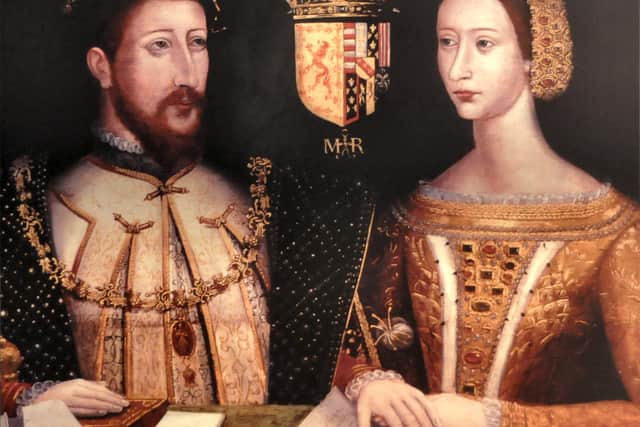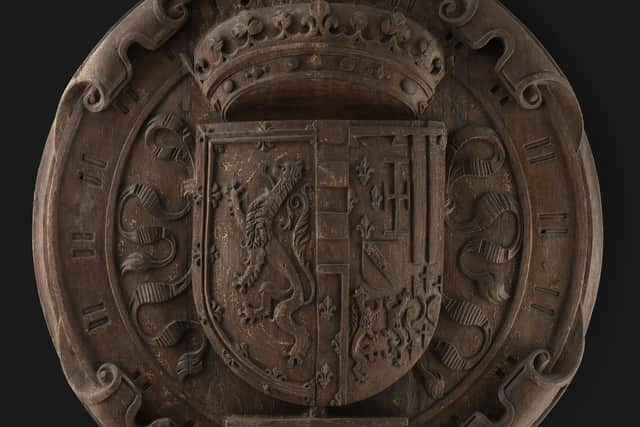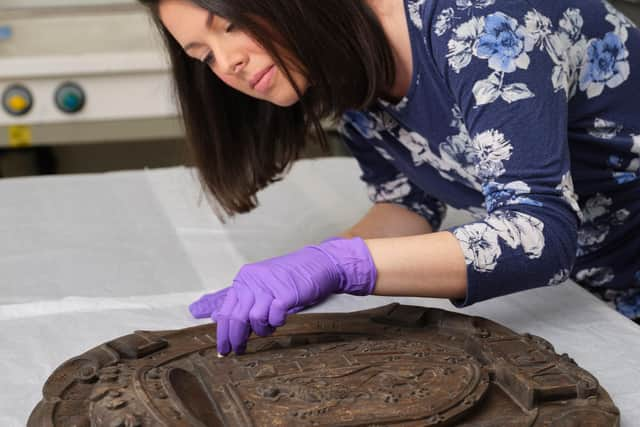Auld Alliance marriage panel of Mary Queen of Scots' parents bought for nation
The purchase of the four armorial roundels by National Museum of Scotland has been made public on the 479th anniversary of the birth of Mary Queen of Scots, the daughter of Mary de Guise and James V, who was born on December 8, 1542.
The panels date from around 1550 and were fixed on the ceiling of Mary de Guise’s now demolished residence in Blythe’s Close in the heart of the Old Town.
Advertisement
Hide AdAdvertisement
Hide AdShe moved there following the death of her husband in 1542 and ruled as Regent of Scotland on behalf of her infant daughter, using the residence to exert her influence and entertain members of nobility and clergy in the final years before the Reformation.


The key roundel depicts the marital union of the couple, who wed to secure the Auld Alliance against England and Henry VIII, with the couple’s individual coat of arms surmounted by a crown. The insignia, which features the Lion Rampant, was later used by Mary Queen of Scots herself.
Dr Anna Groundwater, Principal Curator, Renaissance and Early Modern History at National Museums Scotland said the roundels were a “fantastic” addition to the national collection.
She added: “We can think of Blythe’s Close as a lively place, with the roundels looking down and proclaiming to anyone there the powerful connection between France and Scotland.


“They are important pieces in their own right, and complement our existing collection of material associated with Marie de Guise already on display. We are particularly pleased to add these marital arms of Mary, Queen of Scots’ parents.”
The roundels were acquired by National Museums Scotland at an auction of some 2,000 items stored in the vast attics of Dunrobin Castle, with the panels heading north in the mid 19th Century after they were bought by the Duke of Sutherland, who wanted them to decorate his library.
The four panels, which also reference Henry II of France – Mary de Guise’s father-in-law – the Duke of Châtellerault and an early coat of arms of Edinburgh, fetched £17,750 at auction, with a benefactor supporting the acquisition by the museum.
The residence at Blythe’s Close , which sat off 533 Castlehill, was demolished in 1845 to make way for a new teaching college for the Free Church of Scotland.


Advertisement
Hide AdAdvertisement
Hide AdBy then a crumbling tenement, the roundels had earlier been retrieved by Edinburgh antiquarian Charles Kirkpatrick Sharpe around 1821 as part of a “craze” securing relics of Scotland’s past, Dr Groundwater said.
She added: “There was a very prominent group of antiquarians in Edinburgh, of whom Sir Walter Scott was one, who were very keen to protect and preserve the past which was very quickly disappearing in Scotland, and in Edinburgh, where this modernisation is taking place. It was a real moment in the collections of Scotland. It was like a craze and incredibly fashionable to collect all these items from Scotland’s past."
The roundels will eventually sit in the National Museum of Scotland alongside other items recovered from Blythe’s Court, which include a set of carved oak doors and 16 oak medallion panels.
A message from the Editor:Thank you for reading this article. We're more reliant on your support than ever as the shift in consumer habits brought about by Coronavirus impacts our advertisers.
If you haven't already, please consider supporting our trusted, fact-checked journalism by taking out a digital subscription.
Comments
Want to join the conversation? Please or to comment on this article.
